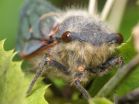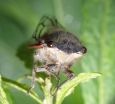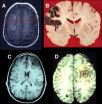University of Montana cicada study discovers 2 genomes that function as 1
2014-08-28
(Press-News.org) MISSOULA, Mont. – Two is company, three is a crowd. But in the case of the cicada, that's a good thing.
Until a recent discovery by a University of Montana research lab, it was thought that cicadas had a symbiotic relationship with two important bacteria that live within the cells of its body. Since the insect eats a simple diet consisting solely of plant sap, it relies on these bacteria to produce the nutrients it needs for survival.
In exchange, those two bacteria, Hodgkinia and Sulcia, live comfortably inside the cicada. Since all three divvy up the nutritional roles, each member of the symbiosis is completely dependent on the others for survival.
So, where does this third-wheel bacterium come into play? That is exactly what UM microbiologist John McCutcheon and his team of colleagues stumbled upon once they started delving deeper into the genome sequence of the essential bacteria. Instead of two bacterial symbionts, they actually identified three. Sulcia was predictably still there, but they found two different kinds of Hodgkinia. What previously was thought to be a tripartite, or a three-way symbiosis, is now proven to actually be a four-way symbiosis.
Their work was published in the Aug. 28 issue of Cell, a prestigious scientific journal in an article titled "Sympatric speciation in a bacterial endosymbiont results in two genomes with the functionality of one."
The researchers discovered that Hodgkinia had subtly become more complex in what McCutcheon explained as a speciation event, in which the original lineage split to produce two separate but interdependent species of Hodgkinia.
"We just didn't expect it," McCutcheon said of this discovery. "I had thought my student made a mistake, but he proved me wrong."
It took a keen eye to identify what were actually two separate versions of the bacteria that were acting as one.
"When we looked at the genes, they were clearly closely related to each other," McCutcheon said. "If there was a broken gene in one version of Hodgkinia, it would be complete and functional on the other and visa-versa. So, the functional genes in each, when working together, seem to operate as one."
Because they only are complete when they operate as a team, they are reliant on each other just as the Sulcia, and ultimately the cicada, is reliant on their contributions to the symbiotic ecosystem.
"This is an obligate symbiosis – all of the organisms in there need each other," McCutcheon said. "We've shown that what was once a three-way symbiosis is now a four-way symbiosis."
This unexpected discovery piqued the interest of McCutcheon, who theorizes that this evolutionary development is a result of "slop and chance." However, this accidental evolution may answer some questions about how other organisms have evolved and become more sophisticated over time.
Hodgkinia's development closely parallels that of a path of some organelles. Essentially, organelles are to cells what an organ is to the human body. Mitochondria of our own cells are organelles, and like Hodgkinia, are derived from symbiotic bacteria.
In the case of the cicada, Hodgkinia's speciation event added a new member to the symbiotic team but it did not add any new functionality to the symbiosis. McCutcheon writes in the paper that, "this process parallels what is observed in some organelles, where massive genome expansions result in little if any observable increase in function."
Understanding the development of organelles is fundamental to understanding the development of life. Because organelles arose such a long time ago, it's impossible to trace back to the specific events that allowed the organelle to become what it is today. By examining Hodgkinia's evolution, researchers in McCutcheon's lab are hoping to gain insight into the storied pasts of organelles whose history has since been erased.
INFORMATION:
The paper will be is published online Aug. 28 at http://www.cell.com/.
For more information, call McCutcheon at 406-243-6071 or email john.mccutcheon@umontana.edu. END
ELSE PRESS RELEASES FROM THIS DATE:
Non-adaptive evolution in a cicada's gut
2014-08-28
Organisms in a symbiotic relationship will often shed genes as they come to rely on the other organism for crucial functions. But now researchers have uncovered an unusual event in which a bacterium that lives in a type of cicada split into two species, doubling the number of organisms required for the symbiosis to survive.
Cicadas of the genus Tettigades feed only on sap they suck out of plants. To create some of the essential amino acids they rely on two bacterial helpers — Candidatus Hodgkinia cicadicola and Candidatus Sulcia muelleri — with which they have lived in ...
How studying damage to the prefrontal lobe has helped unlock the brain's mysteries
2014-08-28
Until the last few decades, the frontal lobes of the brain were shrouded in mystery and erroneously thought of as nonessential for normal function—hence the frequent use of lobotomies in the early 20th century to treat psychiatric disorders. Now a review publishing August 28 in the Cell Press journal Neuron highlights groundbreaking studies of patients with brain damage that reveal how distinct areas of the frontal lobes are critical for a person's ability to learn, multitask, control their emotions, socialize, and make real-life decisions. The findings have helped experts ...
Circulating tumor cell clusters more likely to cause metastasis than single cells
2014-08-28
Circulating tumor cell (CTC) clusters – clumps of from 2 to 50 tumor cells that break off a primary tumor and are carried through the bloodstream – appear to be much more likely to cause metastasis than are single CTCs, according to a study from investigators at the Massachusetts General Hospital (MGH) Cancer Center. Their report in the August 28 issue of Cell also suggests that a cell adhesion protein binding CTC clusters together is a potential therapeutic target.
"While CTCs are considered to be precursors of metastasis, the significance of CTC clusters, which are ...
NYU researchers ID process producing neuronal diversity in fruit flies' visual system
2014-08-28
New York University biologists have identified a mechanism that helps explain how the diversity of neurons that make up the visual system is generated.
"Our research uncovers a process that dictates both timing and cell survival in order to engender the heterogeneity of neurons used for vision," explains NYU Biology Professor Claude Desplan, the study's senior author.
The study's other co-authors were: Claire Bertet, Xin Li, Ted Erclik, Matthieu Cavey, and Brent Wells—all postdoctoral fellows at NYU.
Their work, which appears in the latest issue of the journal Cell, ...
Zombie bacteria are nothing to be afraid of
2014-08-28
VIDEO:
Heidi Arjes of Washington University in St. Louis explains how the failsafes in the bacterial cell cycle work. A bacterium that fails to pass either failsafe enters a zombified state...
Click here for more information.
A cell is not a soap bubble that can simply pinch in two to reproduce. The ability to faithfully copy genetic material and distribute it equally to daughter cells is fundamental to all forms of life. Even seemingly simple single-celled organisms must have ...
Research shows how premalignant cells can sense oncogenesis and halt growth
2014-08-28
Cold Spring Harbor, NY -- What happens inside cells when they detect the activation of a cancer-inducing gene? Sometimes, cells are able to signal internally to stop the cell cycle. Such cells are able to enter, at least for a time, a protective non-growth state.
Since the 1980s, scientists have known that mutations in a human gene called RAS are capable of setting cells on a path to cancer. Today, a team at Cold Spring Harbor Laboratory (CSHL) publishes experiments showing how cells can respond to an activated RAS gene by entering a quiescent state, called senescence.
CSHL ...
Computer games give a boost to English
2014-08-28
If you want to make a mark in the world of computer games you had better have a good English vocabulary. It has now also been scientifically proven that someone who is good at computer games has a larger English vocabulary. This is revealed by a study at the University of Gothenburg and Karlstad University, Sweden.
The study confirms what many parents and teachers already suspected: young people who play a lot of interactive English computer games gain an advantage in terms of their English vocabulary compared with those who do not play or only play a little.
The study ...
NASA's TRMM satellite adds up Cristobal's heavy rainfall in the Caribbean
2014-08-28
The Caribbean Islands of Turks and Caicos were drenched from Tropical Storm Cristobal before the storm moved north and intensified into a hurricane. NASA's TRMM satellite added up the rainfall and revealed the soaking those islands received.
The Tropical Rainfall Measuring Mission or TRMM satellite is like a flying rain gauge in space. It can estimate rainfall throughout storms on Earth from its orbit around the planet. TRMM is managed by both NASA and the Japan Aerospace Exploration Agency known as JAXA and has been in orbit since 1997 covering the tropics.
At NASA's ...
Study finds marine protected areas inadequate for protecting fish and ocean ecology
2014-08-28
A new study reports that an expansion of marine protected areas is needed to protect fish species that perform key ecological functions. According to investigators from the Wildlife Conservation Society and other organizations, previous efforts at protecting fish have focused on saving the largest numbers of species, often at the expense of those species that provide key and difficult-to-replace ecological functions.
Many vital ecological functions of ocean ecology are performed by fish species that also are food for millions of people. This study uncovers a significant ...
NASA's TRMM analyzes Hurricane Cristobal
2014-08-28
VIDEO:
TRMM satellite passed over Cristobal on Aug. 27 at 8:16 a.m. EDT. Cristobal didn't appear round and symmetric in either clouds or rainfall which suggests that the hurricane is being...
Click here for more information.
NASA's Tropical Rainfall Measuring Mission or TRMM Satellite provided a look under the hood of Hurricane Cristobal as it continues moving north and paralleling the U.S. East Coast. NASA's HS3 hurricane mission also investigated the storm. Cristobal is now ...








